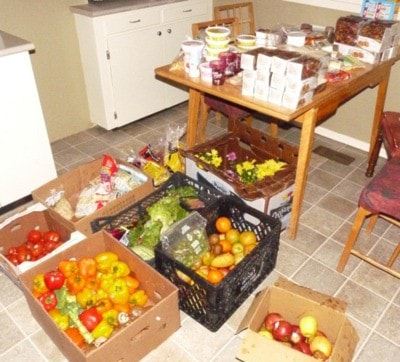Food bills are about to get expensive again for Edward Butterworth and his gang of gleaners.
The Fernwood Urban Gleaners Group had been making use of an unlocked Thrifty Food’s dumpster near Hillside Mall until this week when the dumpster was replaced with a locking food compactor, making it impossible for the group and other individuals to glean.
“It is with great sadness that we note the passing of possibly the last major open dumpster in Victoria,” says Butterworth, who joined the gleaners six months ago at a roommate’s suggestion. “It was our ‘golden’ dumpster, reliably supplying us with enough good food to feed 10 or more hungry mouths.”
Butterworth, 66, is living on “limited means” and does his best to support his university-age daughter, as well as a close single-mom and her family. When all is said and done there’s not a lot of money left for food, but Butterworth also doesn’t consider himself in need of soup kitchens. He sees the gleaners as the perfect solution to recycling and reducing waste.
“I joked that dumpster diving was the best paid job I ever had,” he says. “Organic fruit and veg, $35 spiral-sliced hams, boxes of organic yogurt, milk, bulk nuts, artisan bread. One night I opened a garbage bag to find $400 worth of gourmet imported cheese ... And we enthusiastically recycle all plastics that come over our doorstep that supermarkets and all businesses are free to dump with impunity.”
The group frequented the dumpster after hours, and without consent from Thrifty’s, says Shawn Parkhouse, store manager at the Hillside location.
“Everything in that dumpster is there for a reason, and it would be impossible to call any of it safe. There’s no way to know what it went through, maybe the cooling system stopped working, or what it’s mixed in with: did someone throw bleach water on top of it in the dumpster?” says Parkhouse. “I do feel sad that these people believe we have taken away their food source, but we don’t want any of our customers at risk — whether they’re accessing food through a dumpster, or through the store.”
Parkhouse, who has been with the store for 20 years, emphasizes that Thrifty’s already donates all usable food that would otherwise go to waste to places like the Mustard Seed Food Bank. He also says that the store has never turned down groups in need. Instead of taking undue risks, he wishes support groups would come to him directly for help. When it comes to recycling, Parkhouse says that all compostable produce is taken by Vantreight Farms and that, just this January, Thrifty’s became part of a chain-wide, in-store recycling program that aims for near-zero recycled waste.
Still, Butterworth says he believes there is a lot of room for improvement in the system.
“So many people think we are taking undue risks eating discarded food. But I have spent years wandering the Third World, and understand the rudiments of hygiene and food safety,” he says. “Foodsafe is about ensuring zero liability and thus errs heavily on the side of caution ... I consider myself well-informed enough to take responsibility for my own body and what I put into it.”
For now, the group has located a few other dumpsters around town, but none with the mass products of the Thrifty’s bin.
“In a world where a billion people go hungry, in a society where homelessness is on the increase and people are expected to live on $650 a month on welfare, I want to see laws prohibiting such waste of food,” says Butterworth. “It was taboo when I was young.”
Waste for one and all
Speaking of scraps, residents may be interested to know that city council has now mapped out what will be happening with our own waste come January 2013: an option 35 per cent of respondents asked for.
Of three possible options, council selected “Option B” where collection will occur every two weeks for garbage and kitchen scraps, with backyard pick-up and bins left at the curb for return. The switch will cost an estimated $183 a year per household (a $19 reduction from the current garbage-only program), with a high reduction in greenhouse gas emissions.
In a survey issued by the city last December, 35 per cent of respondents supported “Option B” while 48 per cent supported “Option C” — collection every two weeks of garbage and scraps, with curbside pick-up and return for $161 per year, per household, with a high reduction in emissions. “Option A,” alternating weekly pick-up at $229 a year per household, won a 13 per cent vote.
While “C” was a clear winner, the city says many residents also indicated a desire to maintain backyard pick-up. The Garbage and Kitchen Scraps program aims to reduce the amount of material going to the landfill by 30 per cent. Stay tuned. M
